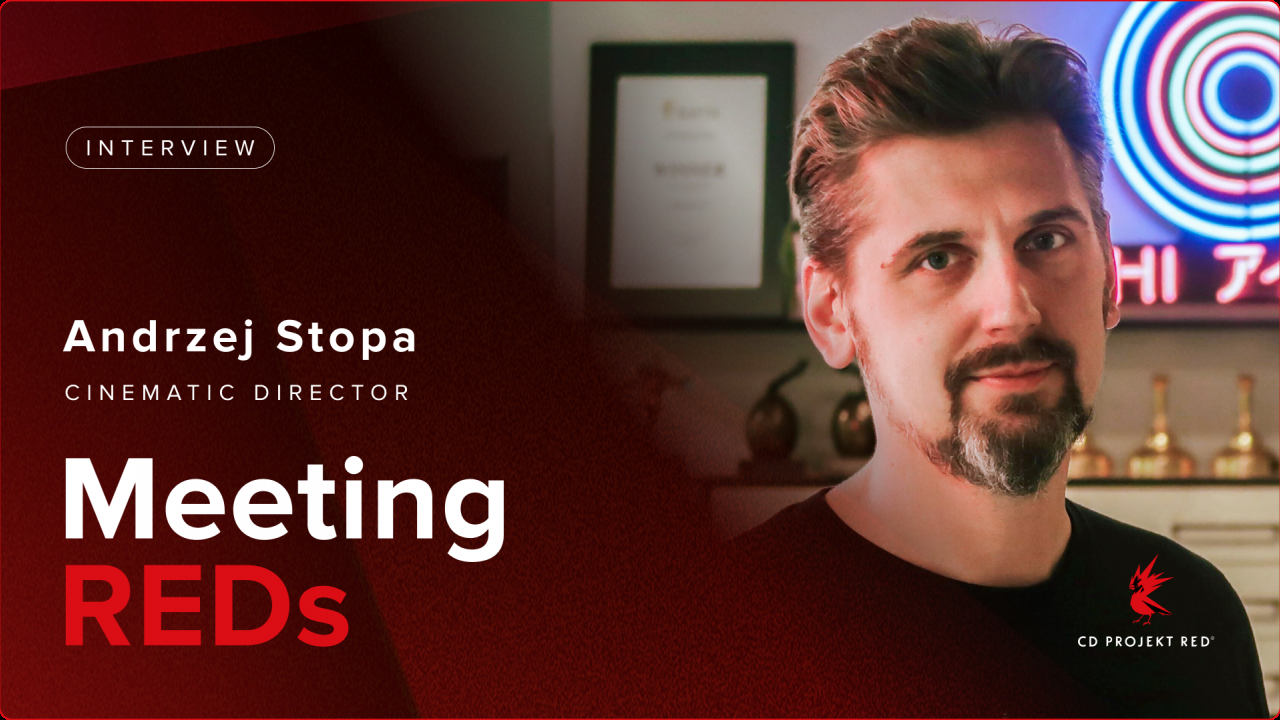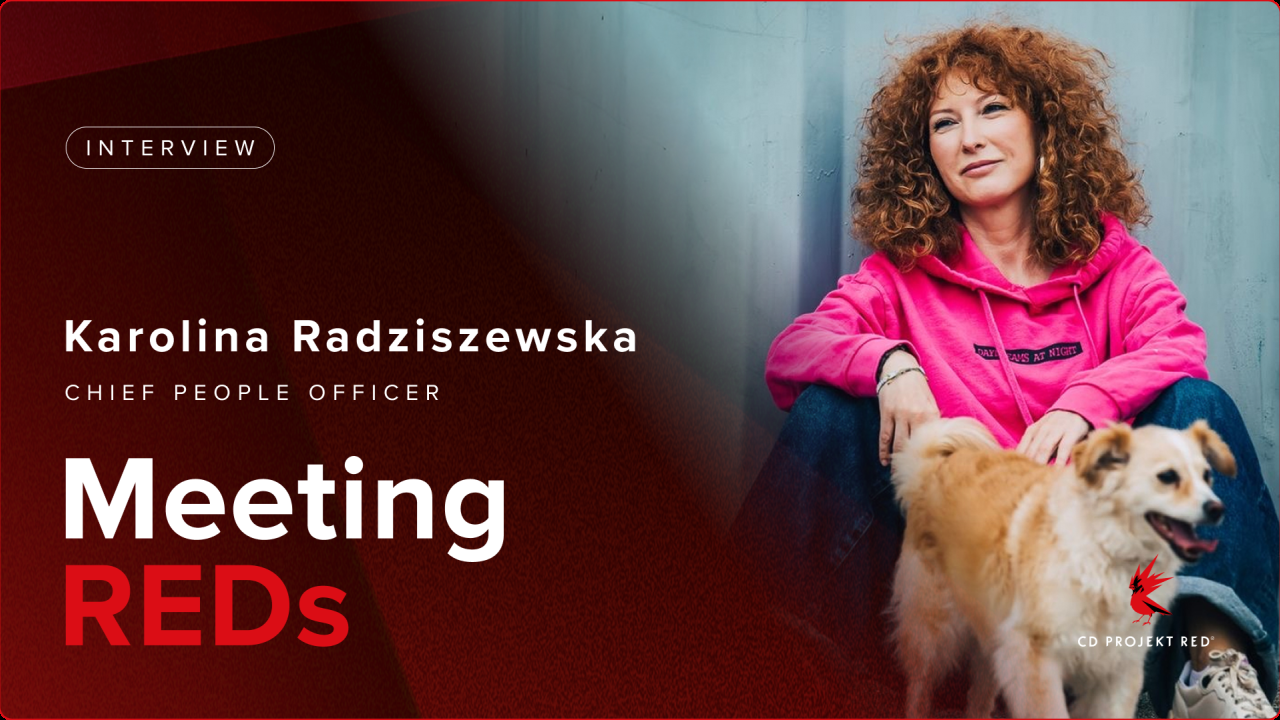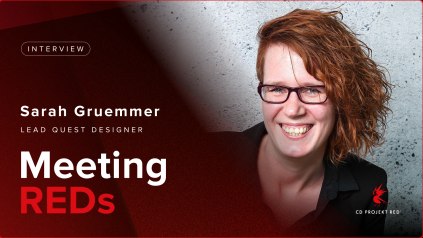The Language of Film in Interactive Storytelling

Our Cinematic Director Andrzej Stopa is currently celebrating his ten-year anniversary at CD PROJEKT RED. Discover how he’s bringing his years of experience — having worked on Cyberpunk 2077 and The Witcher 3: Wild Hunt — to Cyberpunk 2 in Boston.
What do you do at CD PROJEKT RED?
My team and I create interactive moments, with the goal of making them feel like a seamless extension of gameplay. I also oversee the motion capture process, working with actors in staging, discussing subtext, and drawing out genuine emotion. Preparing for these shoots is a lot like film production: we break down the screenplay, plan the shots, and capture performances. The difference is that we layer interactivity on top — so imagine a film where almost every line could branch the story in a new direction.
How did you become Cinematic Director?
I started during the late part of The Witcher 3: Wild Hunt’s development, working on Blood and Wine. That’s where I made my first side quest. When we moved onto Cyberpunk 2077, we moved into the first person perspective and into much more interactive scenes, and this is where I started to become more senior. These interactive scenes are sort of similar to immersive theater — the scene is happening around you but you can influence it. I was part of creating a lot of scenes, starting with the prologue scene with Royce, and I think I did enough where people around me said, “Okay, he’s pretty good at it.” My background is in movies and directing, so I was able to go and help with casting actors for mo-cap shoots and things like that, and eventually I got the lead position on Phantom Liberty. And now that we’ve moved to Boston I have become Cinematic Director. So I started as a regular Cinematic Designer and climbed up.
What are the differences in cinematic design between films and games?
There is a lot of technology in movies but games are on another level. Just today I was checking the progress of moving over our animations to the game engine and that sort of thing — there's a lot more technical stuff. Plus the complication of the branching story. This is much more involved than movies — like, much more. It’s challenging at times; the tools of filmmaking are perhaps more intuitive, where the whole process is very plug and play, and you can do great, great things without deeply understanding the tech, like shooting a movie with an iPhone, for example — Sean Baker did that with Tangerine in 2015. But this isn’t the case with games. We are getting there with Unreal Engine 5, thanks to it being more intuitive and visual-scripting driven, but there is still a lot of technical knowledge needed to create something displayable, and playable!
Was it difficult transitioning from films to games?
I’ve always loved games and wanted to work in games in some capacity — I liked the mixed media aspect, and trying to tell stories with new tools and technologies. I had already dabbled in virtual reality, I played around with and did actually shoot a stereoscopic short movie. I was always interested in new technologies — wondering how I can combine them with storytelling — so games were an obvious choice. Actually, when I was in film school, my thesis was on film narration in games, about the first Bioshock. And even before I finished film school I applied to CD PROJEKT RED a couple of times. I applied for Writer positions, and rightly so they didn't hire me! But then the Cinematic Designer position came up and I thought, “Oh, this is exactly what I should do; this is exactly on the verge of interactive and film.”
Did you know The Witcher games before joining?
Yes, yes! CD PROJEKT was a legend in Poland. And The Witcher too, I read when I was maybe 11 years old, since it’s by a Polish writer. I have a deep fondness for the language and the storytelling in that world, so I applied because of that, because of the reputation of CD PROJEKT and The Witcher itself.
How has cinematic design changed at CD PROJEKT RED over the years?
I think our culture of creating narratives has become more and more collaborative, and I like that a lot. We acknowledge there are different perspectives, and not in a way that means our games are designed by committee, but we let the story evolve through different perspectives — from the writer perspective, the quest design perspective, the cinematic perspective. Each team works to show their part of the story in the best light, and when it comes to us, we ask ourselves, “how can we tell this story visually, without relying on the dialogue?” It’s through this collaborative and iterative process that I think we’re getting to a really high level of storytelling.
What advice would you give to someone eager to join Cinematic Design?
We are looking for people that can handle everything CD PROJEKT RED stands for — the scale and the quality and the ambition. I welcome professionals who feel they are up to the challenge. You get a lot of ownership, you can do a lot here, and it’s fun! We look for people who are very well-versed in cinematic language — people who understand cinema, have a deep knowledge of it, and have a developed perspective on it. We want people who care about the art, who want to develop their own voice in cinematics. Then comes the design part, the game part. An ideal candidate would also understand how to translate all of those ideas into interactive environments, and how the perfect balance between gameplay and cinematics is reached. We want someone with a drive to make interactions into emotional moments themselves.
What’s it like working at CD PROJEKT RED in Boston?
I’d always wanted to move to the United States at some point. Being a movie buff, you see this place in so many movies; you think you’re growing up here almost. But now I’m actually here, and I think Boston is a very cool city to live in. It's beautiful, it's safe, and the atmosphere at CD PROJEKT RED is great here. It's great everywhere, actually — I don't see much of a difference between working in Boston and working in Warsaw or another location. There are small, local differences, of course, but in general, I feel CD PROJEKT RED creates a good atmosphere in every Dev Office. And as we’re expanding the Boston team a lot right now with new hires — for Cyberpunk 2 and Project Sirius, our Witcher multiplayer game — there’s always a ton of energy and excitement.
What excites you most about your work on Cyberpunk 2?
Lots of things excite me about working on Cyberpunk 2! But let's go back to what I said about the scale and complexity and ambition we always have in our storytelling and overall game quality. We’re pushing things even further with Cyberpunk 2 and I can’t wait for players to see what we’re creating. The team here is so passionate and ambitious — I really love it.
Thank you Andrzej, and congratulations on a decade at CD PROJEKT RED! We can’t wait to see what you’re working on in Cyberpunk 2.
AnsweRED PODCAST
Join hosts Paweł Burza and Sebastian Kalemba as they dive into various game development topics with the help of guests from CD PROJEKT RED, Promised Land Art Festival, and the wider industry. This podcast is the perfect listen for anyone interested in game dev; it offers a unique platform to gain valuable insight and knowledge directly from our experts. Tune in today!

 All posts
All posts



























